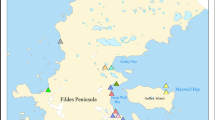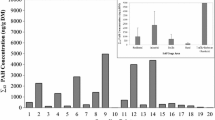Abstract
Using indicator species to monitor the effects of oil pollution was thought to be useful to assess whether local desert reptiles and their insect prey could fulfill such a role in an area damaged in the second Gulf War (1990). Polluted sites with apparently different degrees of contamination (namely tar mat, soot, and clear sites) located at Kuwait’s Greater Al-Burgan oil field were compared with control areas outside this region in study conducted in 2002. Five Acanthodactylus scutellatus lizards from each study and control site were humanely killed and stored in a freezer at −20°C until analysis. Ants from the same sites were also collected and treated in a similar manner. Lizard and ant whole body tissues were subjected to gas chromatography–mass spectrometry (GC–MS) to determine concentrations of petroleum hydrocarbons (HCs). The study concentrated on sixteen polycyclic aromatic hydrocarbons (PAHs), EPA priority pollutants used as indicators of petrogenic HC contamination. There were significantly different concentrations of total PAHs in lizards and ants among all four study sites. Of the 16 PAHs, phenanthrene, fluoranthene, and benzo[a]anthracene were present in both lizard and ant samples from the Greater Al-Burgan oil field sites irrespective of the apparent degree of pollution but were undetectable in materials from the control sites. The range of total PAHs in lizards was 26.5–301 ng g−1 and it was 6.7–82.1 ng g−1 in ants. Concentrations increased progressively along an expected contamination gradient. Total PAHs were detected in biota even in an area (clear site) that did not appear, virtually, to contain petroleum soil pollution which supports the value of indicator biota species. For all three sites where PAHs were found in biota, the ratio of total PAHs in ants to lizards was consistently 3.3–3.4. These data show that, although 12 years have passed since the Kuwait oil spill catastrophe, all sites are still contaminated with PAHs. Use of lizard and ant materials in monitoring such desert locations seems to be an effective strategy.
Similar content being viewed by others
References
Al-Bakri D, Kittaneh W (1998) Physicochemical characteristics and pollution indicators in the intertidal zone of Kuwait: implications for benthic ecology. Environ Manag 22:415–424
Al-Ghunaim A (1997) Devastating oil wells as revealed by Iraqi Documents. Center for Research and Studies of Kuwait, Kuwait
Al-Hashem MA (2006) Effects of oil pollution on the ecology behaviour and Physiology of the Sand Lizard (Acanthodactylus scutellatus) in Kuwait. PhD thesis, University of Wales Swansea, Wales
Al-Hassan JM (1992) Iraqi invasion of Kuwait: an environmental catastrophe. Fahad Al-Marzouk Publishers, Kuwait
Al-Hassan JM, Afzal M, Rao CVN, Fayad S (2000) Petroleum hydrocarbon pollution in sharks in the Arabian Gulf. Bull Environ Contam Toxicol 65:391–398
Culley DD, Applegate HG (1967a) Pesticides at presidio. IV. Reptiles, birds and mammals. Texas J Sci 19:301–310
Culley DD, Applegate HG (1967b) Residues in fish, wildlife and estuaries. Pest Monit J 1:21–28
Fayad N, El-Mubarak A, Edora R (1996) Fate of oil hydrocarbon in fish and shrimp after major oil spill in the Arabian Gulf. Bull Environ Contam Toxicol 56:475–482
IUCN (1983) Impact of oil pollution on living resources. Gland, Switzerland: Commission on Ecology Paper Number 4
Jones DA, Plaza J, Watt I, Al-Sanei M (1998) Long-term (1991–1995) monitoring of the intertidal biota of Saudi Arabia after the 1991 Gulf war oil spill. Mar Pollut Bull 36:472–489
Lambert MRK (1987) Many herpetofauna have insecticide-sensitive prey and could be indicators of habitat condition. In: Van Gelder JJ, Strijbosch H, Bergers PJM (eds) Proceedings of the 4th ordinary general meeting of the societas europaea herpetologica. Faculty of Sciences, Nijmegen
Lambert MRK (1993) Effects of DDT ground-spraying against tsetse flies on lizards in NW Zimbabwe. Environ Pollut 82:231–237
Lambert MRK (1997) Environmental effects of heavy spillage from a destroyed pesticide store near Hargeisa (Somaliland) assessed during the dry season, using reptiles and amphibians as bioindicators. Arch Environ Contam Toxicol 32:80–93
Menzie CA, Potocki BB, Santodonato J (1992) Exposure to carcinogenic PAHs in the environment. Environ Sci Tech 26:1278–1283
Omar SA, Al-Mutawa Y, Zaman S (2000) Vegetation of Kuwait : a comprehensive illustrative guide to the flora and ecology of the desert of Kuwait. Kuwait Institute for Scientific Research, Kuwait
Patnaik P (1999) A comprehensive guide to the hazardous properties of chemical substances. John Wiley and Sons, New York
Perry G, D’miel R (1994) Reproduction and population biology of the fringe-toed lizard, Acanthodactylus scutellatus, in Israel. J Arid Environ 27:257–263
ROPME (1999) Manual of oceanographic observations and pollutant analyses methods (MOOPAM), 3rd edn. ROPME, Kuwait
Walker CH, Ronis MJJ (1989) The monooxygenases of birds, reptiles and amphibians. Xenobiotica 19:1111–1121
White DH, Krynitsky AJ (1986) Wildlife in some areas of New Mexico and Texas accumulate elevated DDE residues, 1983. Arch Environ Contam Toxicol 15:149–157
Wikelski M, Wong V, Chevalier B, Rattenborg N, Snell H (2002) Galapagos Islands: marine iguanas die from trace oil pollution. Nature (Lond) 417:607–608
Author information
Authors and Affiliations
Corresponding author
Rights and permissions
About this article
Cite this article
Al-Hashem, M.A., Brain, P.F. & Omar, S.A. Effects of oil pollution at Kuwait’s greater Al-Burgan oil field on polycyclic aromatic hydrocarbon concentrations in the tissues of the desert lizard Acanthodactylus scutellatus and their ant prey . Ecotoxicology 16, 551–555 (2007). https://doi.org/10.1007/s10646-007-0161-1
Received:
Accepted:
Published:
Issue Date:
DOI: https://doi.org/10.1007/s10646-007-0161-1




